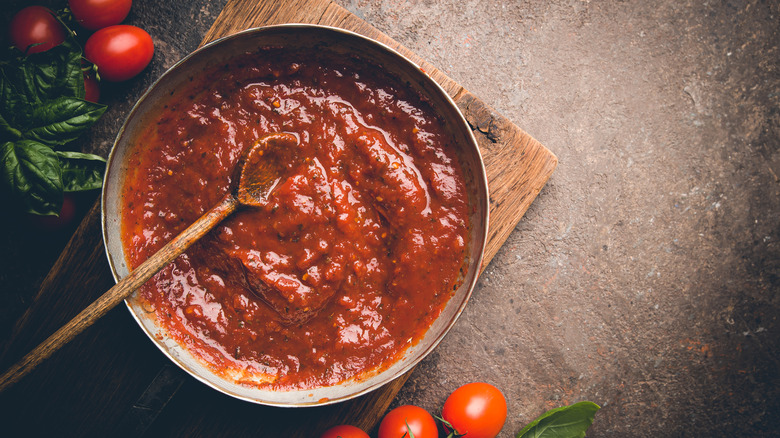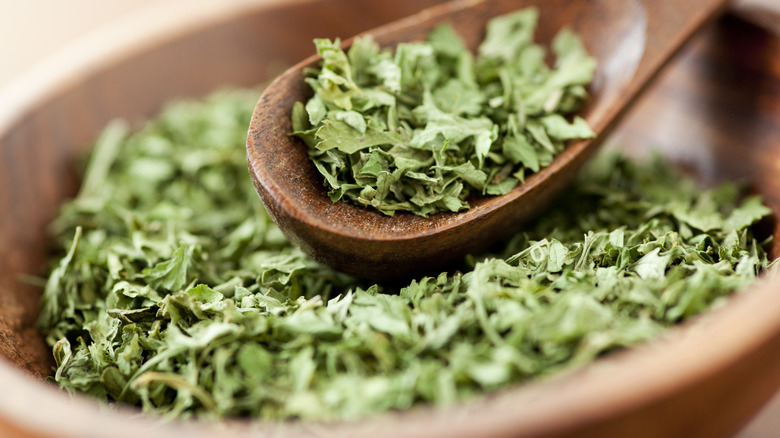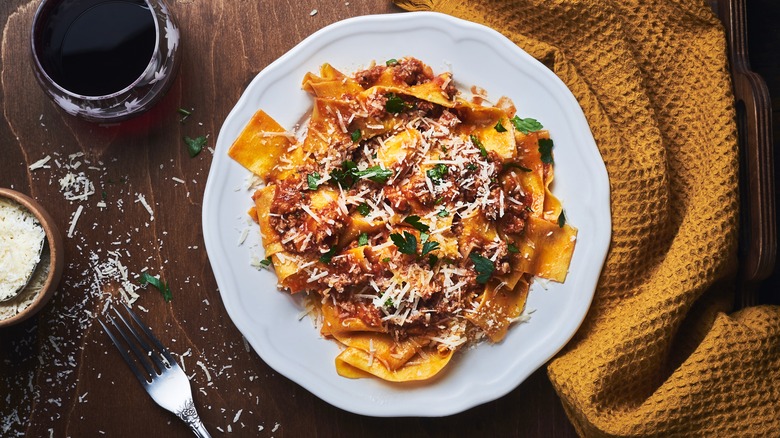The Do's And Don'ts Of Adding Dried Herbs To Pasta Sauce
While jarred marinara tastes fine on its own, most home cooks have their own personal way of making that store-bought pasta sauce really stand out, ranging from adding a bit of bouillon to the sauce to simmering it with sauteed onions or garlic. However, none of these methods might be as versatile as incorporating dried herbs into the mix. Just a dash can really brighten up the taste of your food, but there are a few things you should keep in mind to make your sauce's flavor really shine.
Not all herbs remain as vibrant as their fresh counterparts when dried. Typically, sturdy, woody aromatics like bay leaves, rosemary, and oregano still taste potent when dehydrated. Delicate leafy herbs like basil and parsley, on the other hand, become extremely mellow. This makes them less suitable for a marinara, as their flavors can easily get masked in a rich sauce — you're better off buying them fresh at the supermarket. Just a sprig of basil or parsley can really add some brightness to a marinara, especially when paired alongside earthier, dried aromatics. Herbs of all kinds are one of the best ways to liven up spaghetti and other pastas, so don't be afraid to mix and match.
Bloom your dried herbs to boost flavor
In the culinary world, "blooming" refers to the process of toasting spices or sauteing aromatics in dry heat or oil. This technique releases fat-soluble compounds that wouldn't be as pronounced if the ingredients were simply simmered in a sauce. Blooming is particularly beneficial when enhancing a pasta sauce with dried herbs, as it helps extract maximum flavor. While it might seem like an extra step when you're quickly trying to prepare some rigatoni, it actually takes just about half a minute to activate the flavor of dehydrated herbs like rosemary or oregano.
After blooming your dried herbs, you can choose to add them to your pasta sauce either early or late in the simmering process. Woody aromatics should ideally be introduced at the beginning, allowing their flavor compounds ample time to infuse the sauce. Don't be afraid to incorporate the oil or butter used for blooming into the mix either, as many home cooks find that butter in particular adds a rich, savory note. If you've chosen to utilize fresh herbs in conjunction with dried ones, add the fresh herbs a few minutes before the sauce is finished cooking to preserve their flavors.
Add some meat and cheese for further richness
Dried herbs are not the only way to add complexity to a jar of pasta sauce, as meats can also be used alongside these aromatics to make the marinara richer. You'll want to select fattier proteins that can not only render excellently in a saucepan, but also cook relatively quickly. Ground meat, pancetta, and sausage are excellent candidates here, but feel free to fry up dark poultry meat alongside some lardons to keep things juicy. To prevent the meat from burning, transfer it to a separate container to use later, but retain the rendered fat in the pan. This fat can be used to bloom your dried herbs and then be mixed into your sauce, adding more depth as a result.
Cheeses are another great way to make pasta sauce more exciting, as their creaminess can easily balance out the acidity of tomatoes. Mascarpone and ricotta are excellent for thickening a marinara, but if you don't want to significantly alter its texture, feel free to sprinkle in some parmesan or mozzarella at the end. Don't let any cheese go to waste; professional chef Giada De Laurentiis adds cheese rinds to pasta sauce to give it a savory undertone, and make it feel smoother.



